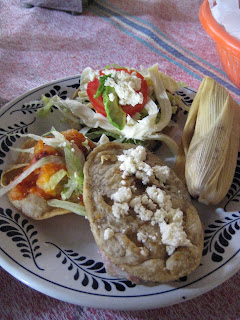
As I ate lunch on Wednesday, I thanked God that I had run 2.5 miles uphill towards Monte Alban earlier that day. My judgment may have been clouded by drink, as I started drinking my Bohemia beer and eating tortilla chips like a madwoman before my food came, but I have never tasted such delicious pork fat in my life as I did at El Biche Pobre.
I had spent nearly all morning in the kitchen at Puente, trying to make amaranth-corn tortillas from scratch. I had boiled dried corn kernels with limestone the day before and let it sit overnight, and then rinsed carefully and rubbed away at each husk, almost individually, as per these
instructions (which turned out to be wrong since the corn kernels need to be cooked 15 minutes or more). Rather than take a handful of corn and amaranth to the molino, I’d lugged my molcajete to work on the bus and decided to grind away by hand. One of the staff laughed and said I was “una mujer de campesinos,” or a peasant woman. The temperature in the office is cool, even in the kitchen, but I started to get so hot as I mashed away at that corn, and when I tried to grind the amaranth, I had to deal with the sticky paste that stuck to the mortar, the pestle, me, and everything else it came in contact with.
For all that work, since I hadn’t made very much masa or dough, I got 6 measly little tortillas. (They had good flavor, but they were too inflexible to be tortillas, memelitas maybe.) I ate one of them, and other than a banana, nothing else from breakfast to 3 p.m., when I left work. I felt like a crazed, hungry animal.
I’d never heard of “El Biche Pobre” until that day, but I caught a mention of it in a TripAdvisor thread and when I Googled it, it turned out to be one of Rick Bayless’s
favorites. As I am becoming increasingly maniacal in my devotion to him, that was enough to get me lurching towards Calzada de la Republica 600, at the corner of Hidalgo, just two blocks east of El Llano park.
“El Biche Pobre” calls itself a “comedor familiar,” which I assume means “down-home food.” They’re particularly famous for their botanas, or bar snacks, and instead of getting a proper meal of soup, rice, meat, and tortillas, I opted for the botana plate for one, one of all of the above. Of course, since I was eating bar snacks, I had to have a beer.

Immediately, I knew I was somewhere special. The chips that came in the plastic basket were perfect, crispy, completely dry and without grease, with so much flavor they didn’t need salt, maybe just a dab or two one or the other of their salsas, green and red, and their guacamole. I was also given a little bowl of pickled dried peppers, onions, and garlic. I sucked the garlic out of their little papery jackets, licking my fingers and not caring what I looked like. That was probably the beer. I’d had pickled garlic before, but not like this, where they had been softened by cooking and then marinated in a vinegary sauce, like an escabeche. The dried peppers were also fantastic, smoky and intense but not so hot that I couldn't taste anything else.

When my plate came, I honestly felt the slightest bit of disappointment. I’d read that their botana plate for one was huge, and this, while ample, wasn’t actually incredible. And then they brought out the second plate.

On the first plate, clockwise from the top: a fried taquito with guacamole; a piece of cold pork with avocado, tomato and pickled jalapeno; a quesadilla with cheese and epazote; a chile relleno; some pieces of pork milanesa; a bocadillo de papas or potato croquette; and the piece-de-resistance in the middle, “carne frita” or fried meat.
On the second plate, clockwise from the tamal: a tamal of frijoles sitting on top of another piece of cold meat; a memela with lard and crumbled cheese; a tostada with potatoes; and another tostada with beans, cheese, tomato and avocado.
I will only touch upon what truly moved me.
When I put a small piece of the “carne frita” in my mouth, I almost shouted, “What is this?” When I asked the waiter, all he could say was “meat of the pork,” “meat of the pork,” so I still don't really know what made it so delicious. I am not normally a huge pork fat eater. I love fat for the way it conveys flavors, not so much in and of itself, but this made me realize that just plain old fat could be wonderful. It wasn’t like carnitas that melt in your mouth, or the porchetta-like roast I made last winter that practically collapsed in its own fat. It held itself together, with a good chewy texture, a lovely crispy exterior, and a melting layer of fat in the middle. Such a tiny piece to pack such a punch.
The chile relleno was my second favorite. Instead of using a fresh chile, they had taken a dried pasilla chile and filled it with more pork, shredded this time. It had a slightly sweet flavor, but almost the flavor of sweet hot peppers rather than a more straightforward, insipid sweetness.
The memela was very simple, just a crunchy, almost tough, corny little oblong, brushed with nothing more than “asiento” or lard and garnished with a little crumbled cheese. Its simplicity was its charm, like eating a perfect baguette with butter from French cows.
I loved the pork milanesa, more than any other I’ve had here, because the breading was greaseless and well-salted. Is “milanesa” really mean that it’s from Milan? And is “milanesa” preparation related at all to Japanese fried pork cutlet, donkatsu? Sometimes, I'm embarrassed to say all my lefty politics goes out the window when I think about the food benefits of globalization.
Everything else was very good, except the bocadillo de papa which was just boring.
I staggered out of the restaurant almost dazed. I had to get home as quickly as possible so I could lie down, but having woken up at 6:30 in the morning to go running with my neighbor and her friend, my legs hurt. But I still stopped for a cantaloupe paleta at Popeyes.

